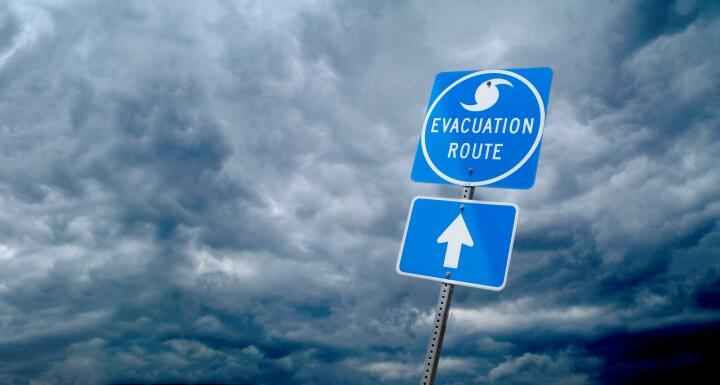Heavy and consistent rainfall this summer, even before Tropical Storms Hermine and Julia and Hurricane Matthew, produced a tremendous amount of stormwater. Grass swales were too saturated to allow infiltration, and retention ponds were full, discharging stormwater into streets or surface waters. Managers at industrial operations had to inspect plant sites more frequently after heavy rainfall to ensure no stormwater escaped except as allowed under the facility's stormwater permit. Federal and state enforcement personnel also conducted inspections of their own, finding opportunities to issue notices of violation ("NOV") of stormwater regulations. Industries at the receiving end of an NOV found out it is more expensive than ever to pay for runoff.
Background: Industrial Stormwater Regulation
In the initial years after the passage of the 1972 Clean Water Act amendments, the United States Environmental Protection Agency ("EPA") focused on controlling the discharge of industrial process wastewater and municipal sewage through its National Pollutant Discharge Elimination System ("NPDES") permit program.
Once water quality stabilized after EPA's implementation of treatment standards for the discharge of toxic and conventional pollutants from point sources, the agency shifted its focus to tackling pollutants discharged from diffuse, or "nonpoint" sources as the result of wet weather: that is, stormwater. Further, amendments to the Clean Water Act in 1987 included a comprehensive new scheme for stormwater. Since the inclusion of stormwater in the NPDES program, discharges composed entirely of stormwater from industrial and construction activities and municipalities have been subject to tighter controls under the applicable permits.
NPDES Permit Requirement
Since 1994, discharges associated with industrial activity have required compliance with an NPDES Stormwater Permit. Industries falling within one of the Standard Industrial Classification Codes need a permit for stormwater discharge associated with industrial activities at facilities such as plant yards, access roads, rail lines used to carry material and products, material handling sites, refuse sites, shipping and receiving areas, storage areas for raw materials and products, and areas where industrial activity has occurred in the past where significant materials remain and are exposed to rainfall.
Most industries seek coverage under one of several General Permits available for various categories of regulated industrial activity such as: heavy manufacturing including paper mills, chemical plants, refineries, steel mills; coal and mineral mining; hazardous waste treatment, storage and disposal facilities; landfills and dumps holding industrial waste; metal scrapyards, automobile salvage and junkyards; battery reclaimers; power generating plants; transportation facilities; and light manufacturing including food processing, printing and publishing, public warehousing and storage, and electronic equipment manufacturing.
Enforcement
The EPA has authorized most states to implement the NPDES stormwater permitting program while retaining concurrent enforcement jurisdiction. In North Carolina, the Department of Environmental Quality administers the program through the Division of Energy, Minerals, and Land Resources ("DEMLR"). General Permit terms and conditions typically are a combination of stormwater pollution prevention plans ("SWPPP"), monitoring, and numeric effluent limitations.
Although the DEMLR generally issues and enforces NPDES industrial stormwater permits, the EPA has the discretion to exert its enforcement authority. The EPA often becomes involved in cases of significant violations or those which are the subject of its current National Enforcement Initiatives. Sometimes, EPA Regional Offices will target a particular watershed of interest, and then identify high priority industries in the area to inspect and provide enforcement training opportunities for federal and state personnel. Enforcement inspections include a review of the SWPPP, inspections records, monitoring reports, and a site inspection to verify that the SWPPP has been implemented and that best management practices ("BMP") are sufficient and adequately maintained to control stormwater at the facility. Common violations include inadequate SWPPPs, inadequate documentation of inspections after heavy rainfall or failure to document corrective actions, and effluent limitation violations.
Once the EPA issues an NOV, it has several options. The EPA can use Administrative Compliance Orders for smaller site-specific violations to require the industry to correct deficiencies within a period of time and submit a compliance letter. Alternatively, it can initiate an administrative enforcement action for company-wide deficiencies identified at multiple sites or for significant site-specific violations.
The EPA reserves judicial enforcement actions for cases involving significant environmental damage or cases of national importance.
When civil penalties will be pursued, the Clean Water Act requires the EPA to weigh fact-specific considerations to determine the amount of penalties to be assessed, including the nature and circumstances of the violation, the extent and gravity of the violation, the violator's history of prior violations, the violator's ability to pay, and any economic benefit or savings resulting from the violation. Among the EPA's environmental goals is the imposition of penalties large enough to deter future noncompliance by the violator and others and to ensure violators obtain no advantage over competitors by deriving an economic benefit from avoiding compliance with the Clean Water Act.
EPA's Industrial Stormwater Settlement Penalty Policy
Many civil enforcement actions do not reach trial and are settled by the EPA. When negotiating a settlement the EPA now will follow the "Supplemental Guidance to the 1995 Interim Clean Water Act Settlement Penalty Policy for Violations of the Industrial Stormwater Requirements" ("2016 Supplement Guidance"). The 2016 Supplemental Guidance is an update to the Interim Clean Water Act Settlement Policy ("1995 Settlement Policy") originally adopted as a method for EPA staff to calculate nationally consistent minimum penalties for settlement of any Clean Water Act violation. In 2008, the EPA developed supplemental guidance to the 1995 Settlement Policy specifically for violations of stormwater requirements for construction activities. In 2016, it did the same for violations of industrial stormwater requirements.
The original 1995 Settlement Policy created a methodology for analyzing the statutory considerations to calculate a settlement penalty based on the following formula:
Penalty = Economic Benefit + Gravity +/- Gravity Adjustment Factors – Litigation Considerations – Ability to Pay – Supplemental Environmental Projects.
The 1995 Settlement Policy contains in-depth discussions of the components of the formula and how each is to be determined, including value ranges, tables, and computer models. The 2016 Supplemental Guidance does not change the overall formula, but emphasizes and adjusts four of factors in order to tailor the settlement penalty specifically for industrial stormwater cases.
Economic Benefit
The violator gains an economic benefit from either avoiding or delaying costs that would otherwise have been incurred by complying with industrial activity requirements. The 1995 Settlement Policy addresses calculation of the value of monitoring and reporting requirements, capital expenditures, and operation and maintenance.
The 2016 Supplemental Guidance adds the following factors into the total Economic Benefit calculation:
- Failure to obtain an NPDES Permit;
- Failure to develop a SWPPP;
- Failure to implement stormwater controls or BMPs;
- Failure to maintain stormwater controls or BMPs;
- Failure to regularly inspect stormwater controls or BMPs; and,
- Failure to monitor or report.
Gravity
The 2016 Supplemental Guidance modifies the 1995 Settlement Policy calculation of the Gravity Component to fit the circumstances of industrial stormwater violations using factor-specific tables with ranges of values. The Gravity Component of an industrial stormwater violation includes:
- Significance of Effluent Violations: A calculation based on whether the facility violates a numeric effluent limitation in its NPDES Stormwater Permit;
- Health and Environmental Harm: A calculation that identifies the harm and assigns a value based on tables, including many considerations such as the quality classification of the surface water receiving the discharge and whether it is listed as impaired for certain pollutants; the duration of the noncompliance; actual impacts or potential harm to human health or the environment; prioritization of the industry based on the level of threat to the environment from the industrial activity; and, whether drinking water supplies and stream beds are impacted; and,
- Non-Effluent Limit Violations: A six step calculation using tables that consider the category of non-numeric effluent limit violations based on severity and duration of the violation, the size and sophistication of the owner or operator of the industrial activity, and whether the discharge occurred without an NPDES Stormwater Permit.
Gravity Adjustment Factors
The 2016 Supplemental Guidance applies two of the original four Gravity Adjustment Factors to industrial stormwater violations. The EPA will continue to use the History of Recalcitrance Factor to increase penalties. A violator's history can include bad faith, an unjustified delay in preventing, mitigating, or remedying a violation, and failure to comply with previous Administrative Compliance Orders. The EPA will use the Quick Settlement Adjustment Factor to reduce a penalty by ten percent as extra incentive for timely settlement.
Litigation Considerations
The 2016 Supplemental Guidance encourages EPA staff to take into account the Litigation Considerations in the 1995 Settlement Policy. The EPA may reduce the amount of civil penalty it will accept to settle a case where it recognizes weaknesses in its own case because the facts demonstrate a substantial likelihood it will not achieve a higher penalty at trial. Possible considerations include reliability of evidence or witnesses and statements made by federal, state or local regulators that may allow the violator to credibly argue that it believed it was complying with the Clean Water Act.
The 2016 Supplemental Guidance is used in settlements only, and the EPA will not disclose its internal calculations during negotiations. If the matter does not settle and proceeds to a hearing or trial, the EPA will pursue the full extent of civil penalties available under the law.
Increased Civil Penalties for Noncompliance
Compounding the effect of the 2016 Supplemental Guidance is the EPA's recent update of the maximum civil penalties available for federal environmental violations. Major environmental statutes mandate the maximum civil penalty amount that the EPA can impose for each violation for each day it occurs or continues. The penalty amounts set in the statutes have been increased occasionally, but have not kept up with inflation.
In July 2016, the EPA increased those maximum civil penalties in response to Congress's 2015 amendment to the Federal Civil Penalties Inflation Adjustment Act ("Civil Penalty Inflation Adjustment"). The first increase was an initial "catch up" adjustment to civil penalties effective July 1, 2016 for violations occurring on or after November 2, 2015 and assessed on or after August 1, 2016. The second increase will be an annual adjustment beginning January 15, 2017. Amounts vary across environmental statutes, but the effect on the Clean Water Act means Class I penalties for individual stormwater violations, originally set at $25,000 per violation per day and adjusted for inflation to $37,500, were increased to $51,570 per violation. Class II penalties for continuous stormwater violations, originally set at $125,000 and adjusted for inflation to $187,500, were increased to $257,848. A combination of stormwater violations could lead to the EPA assessing an astronomical civil penalty against a violator.
Conclusion
The cost of environmental non-compliance has increased under the factor-intensive 2016 Supplemental Guidance and will continue to do so annually under the Civil Penalty Inflation Adjustment. Industries must invest time and money in compliance assessments and self-audits to identify issues, be proactive about corrective measures, and stay in compliance
Third-party auditing in consultation with legal counsel can help control enforcement costs. Settlement negotiations can result in reduced penalties. However, the EPA will pursue the maximum available penalties absent settlement. Defending and resolving industrial stormwater violations are more important and expensive than ever – so, best to keep the EPA from knocking on the door.









